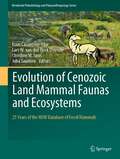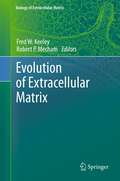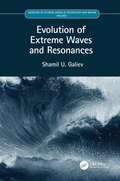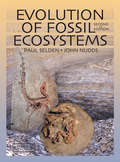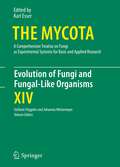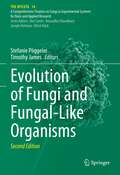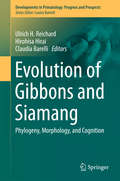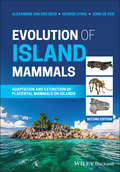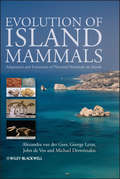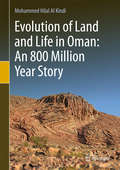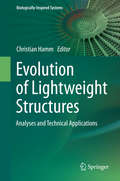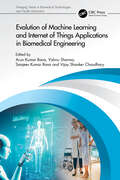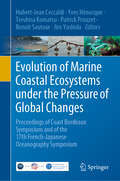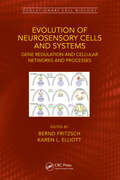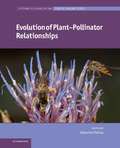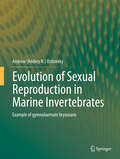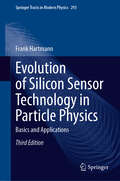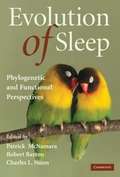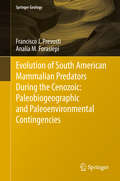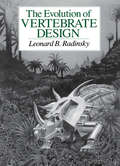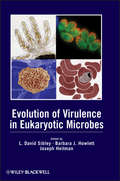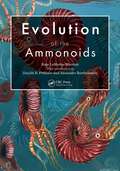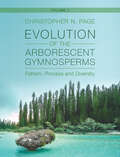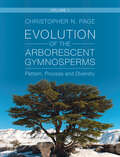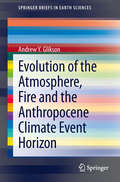- Table View
- List View
Evolution of Cenozoic Land Mammal Faunas and Ecosystems: 25 Years of the NOW Database of Fossil Mammals (Vertebrate Paleobiology and Paleoanthropology)
by Christine M. Janis Isaac Casanovas-Vilar Lars W. van den Hoek Ostende Juha SaarinenThis volume presents an array of different case studies which take as primary material data sourced from the NOW (‘New and Old Worlds’) database of fossil mammals. The NOW database was one of the very first large paleobiological databases, and since 1996 it has been expanded from including mainly Neogene European land mammals to cover the entire Cenozoic at a global scale. In the last two decades the number of works that are based in the use of huge databases to explore ecological and evolutionary questions has increased exponentially, and even though the importance of big data in paleobiological research has been outlined in selected chapters of general works, no volume has appeared before this one which solely focuses on the databases as a primary source in reconstructing the past. The purpose of this book is to provide an illustrative volume showing the importance of big data in paleobiological research, and presenting a broad array of unpublished examples and case studies. The book is mainly aimed to professional palaeobiologists working with Cenozoic land mammals, but the scope of the book is broad enough to fit the interest for evolutionary biologists, paleoclimatologists and paleoecologists.The volume is divided in four parts. The first part includes two chapters on the development of large paleobiological databases, providing a first-hand account on the logic and the functioning of these databases. This is a much-needed perspective which is ignored by most researchers and users of such databases and, even if centered in the NOW database, the lessons that can be learned from this part can be extended to other examples. After this introductory part, the body of the book follows and is divided into three parts: patterns in regional faunas; large scale patterns and processes; and ecological, biogeographical and evolutionary patterns of key taxa. Each chapter is written by well-known specialists in the field, with some participation of members of the NOW advisory board. The array of selected mammal taxa ranges from carnivores, equids, ruminants and rodents to the genus Homo. The topics studied also include the diversification and radiation of major clades, large-scale paleobiogeographical patterns, the evolution of ecomorphological patterns and paleobiological problems such as evolution of body size or species longevity. In most cases the results are discussed in relation to protracted environmental or paleogeographic changes.
Evolution of Extracellular Matrix
by Robert Mecham Fred W. KeeleyThe evolution of single cells into multicellular organisms was mediated, in large part, by the extracellular matrix. The proteins and glycoconjugates that make up the extracellular matrix provide structural support to cellular complexes, facilitate cell adhesion and migration, and impart mechanical properties that are important for tissue function. Each class of ECM macromolecule has evolved to incorporate distinctive properties that are defined by conserved modules that are mixed together to achieve appropriate function. This volume provides a comprehensive analysis of how the major ECM components evolved over time in order to fill their specific roles found in modern organisms. The major focus is on the structural matrix proteins, matricellular proteins, and more complex ECM structures such as basement membranes. Adhesive proteins and their receptors are also discussed.
Evolution of Extreme Waves and Resonances: Volume I (Modeling of Extreme Waves in Technology and Nature)
by Shamil U. GalievThe theory of waves is generalized on cases of strongly nonlinear waves, multivalued waves, and particle–waves. The appearance of these waves in various continuous media and physical fields is explained by resonances and nonlinearity effects. Extreme waves emerging in different artificial and natural systems from atom scale to the Universe are explored. Vast amounts of experimental data and comparisons of them with the results of the developed theory are presented. The book was written for graduate students as well as for researchers and engineers in the fields of geophysics, nonlinear wave studies, cosmology, physical oceanography, and ocean and coastal engineering. It is designed as a professional reference for those working in the wave analysis and modeling fields.
Evolution of Fossil Ecosystems
by Paul Selden John NuddsEvolution of Fossil Ecosystems describes all of the main Fossil Lagerstätten (sites of exceptional fossil preservation) from around the world in a chronological order. It covers the history of research, stratigraphy and taphonomy, main faunal and floral elements, and the palaeoecology of each site and gives a comparison with coeval sites around the w
Evolution of Fungi and Fungal-Like Organisms
by Johannes Wöstemeyer Stefanie PöggelerBased on sequence analyses of many different genes, the past decade has provided us with a profound knowledge of fungal systematics and phylogeny. In addition, a number of sequences of complete fungal genomes have been identified and several others will soon follow. In this volume, leading experts address questions concerning the origin of the fungal kingdom and fungal evolution at a level of analytical refinement that has never been possible before. The following major aspects are highlighted: evolutionary roots of fungi; evolution of signaling in fungi and fungal-like organisms; evolution of mutualistic systems and metabolism in fungi; and evolutionary mechanisms and trends.
Evolution of Fungi and Fungal-Like Organisms (The Mycota #14)
by Stefanie Pöggeler Timothy JamesSequence analyses of numerous fungal genomes over the past two decades have provided us with extensive insights into the phylogenetic relationships of fungi and the distribution of genes and their inferred functions, across the fungal kingdom. It is now possible to answer questions about the origin of the fungal kingdom and fungal evolution with an analytical precision that was not possible before.This fully revised and updated 2nd edition of The Mycota, Vol. 14, addresses major aspects of fungal evolution. The book is divided into four sections covering the following main topics:• Evolutionary roots of fungi• Evolution of pathogenic strategies• Evolution of mutualistic interactions• Evolution of metabolism and development in fungiFungi are among the oldest eukaryotic groups in the living world. The aim of this book is to better understand the history and importance of fungi, as well as the characteristics that distinguish them from their sister group, the metazoans, and other fungus-like groups such as the slime molds and oomycetes. Many fungal species are important pathogens of animals and plants and have distinct but parallel pathogenicity strategies. Mutualistic interactions of fungi with other organisms are crucial for their survival in different ecological niches and have a great influence on their evolution and the design of their genomes. Metabolism is one of the most important features of life, and the diversity of metabolic processes is best understood by considering evolution. Studies of fungal metabolism have traditionally focused on metabolites of particular interest, namely mycotoxins, pathogenicity factors, antibiotics, and other compounds with interspecific activity. This volume will be of great interest to mycologists, evolutionary biologists, and fungal geneticists, as well as to lecturers and students of microbiology and mycology.
Evolution of Gibbons and Siamang
by Hirohisa Hirai Ulrich H. Reichard Claudia BarelliThis volume provides insight into gibbon diet and community ecology, the mating system and reproduction, and conservation biology, all topics which represent areas of substantial progress in understanding socio-ecological flexibility and conservation needs of the hylobatid family. This work analyzes hylobatid evolution by synthesizing recent and ongoing studies of molecular phylogeny, morphology, and cognition in a framework of gibbon and siamang evolution. With its clearly different perspective, this book is written to be read, referenced, and added to the bookshelves of scientists, librarians, and the interested public.
Evolution of Island Mammals
by George Lyras Alexandra van der Geer John de VosEvolution on islands differs in a number of important ways from evolution on mainland areas. Over millions of years of isolation, exceptional and sometimes bizarre mammals evolved on islands, such as pig-sized elephants and hippos, giant rats and gorilla-sized lemurs that would have been formidable to their mainland ancestors. Evolution of Island Mammals, Second Edition, provides an updated and expanded overview of the current knowledge on fossil island mammals worldwide, ranging from the Oligocene to the onset of the Holocene. The book addresses evolutionary processes and key aspects of insular mammal biology, exemplified by a variety of fossil species. Readers familiar with the first edition will find here a host of updated and enhanced material, including: An entirely new chapter on the island rule  Updated and expanded theoretical chapters Updated and improved taxonomic information Extensive coverage of new discoveries Body masses or body size indices for most extinct island mammals New figures visualizing the richness of the fossil record This accessible and richly illustrated textbook is written for graduate level students and professional researchers in evolutionary biology, palaeontology, biogeography, zoology, and ecology.
Evolution of Island Mammals: Adaptation and Extinction of Placental Mammals on Islands
by George Lyras Michael Dermitzakis Alexandra van der Geer John de VosEvolution on islands differs in a number of important ways from evolution on mainland areas. Over millions of years of isolation, exceptional and sometimes bizarre mammals evolved on islands, such as pig-sized elephants and hippos, giant rats and gorilla-sized lemurs that would have been formidable to their mainland ancestors. This timely and innovative book is the first to offer a much-needed synthesis of recent advances in the exciting field of the evolution and extinction of fossil insular placental mammals. It provides a comprehensive overview of current knowledge on fossil island mammals worldwide, ranging from the Oligocene to the onset of the Holocene. The book addresses evolutionary processes and key aspects of insular mammal biology, exemplified by a variety of fossil species. The authors discuss the human factor in past extinction events and loss of insular biodiversity. This accessible and richly illustrated textbook is written for graduate level students and professional researchers in evolutionary biology, palaeontology, biogeography, zoology, and ecology.
Evolution of Land and Life in Oman: an 800 Million Year Story
by Mohammed Hilal Al KindiThis book takes readers on a fascinating journey to discover the story of land and ancient life evolution in Oman since at least 800 million years ago. Oman is well known for its marvelous geology. What tectonics affected this part of the world and what organisms lived there? How did the climate and life develop? Did life forms become more complex and varied or become extinct and disappear forever? The book thoroughly reconstructs this land and ancient life evolution and offers readers an understanding on how land, climate and life have proceeded and developed in Oman through the millions of years.
Evolution of Lightweight Structures
by Christian HammThis volume contains studies on the evolution and function of lightweight constructions of planktonic and other organisms, and examples of how they can be used to create new solutions for radical innovations of lightweight constructions for technological application. The principles and underlying processes responsible for evolution and biodiversity of marine plankton organisms are highly relevant and largely unresolved issues in the field of marine science. Amongst the most promising objects for the study of evolution of stable lightweight constructions are marine organisms such as diatoms or radiolarians. Research in these fields requires interdisciplinary expertises such as in evolutionary modelling, paleontology, lightweight optimization, functional morphology, and marine ecology. Considerable effort and expert knowledge in production engineering or lightweight optimization is necessary to transfer knowledge on biogenic structures and evolutionary principles into new lightweight solutions. This book show methods and examples of how this can be achieved efficiently.
Evolution of Machine Learning and Internet of Things Applications in Biomedical Engineering (Emerging Trends in Biomedical Technologies and Health informatics)
by Arun Kumar Rana Vishnu Sharma Sanjeev Kumar Rana Vijay Shanker ChaudharyThis book provides a platform for presenting machine learning (ML)-enabled healthcare techniques and offers a mathematical and conceptual background of the latest technology. It describes ML techniques along with the emerging platform of the Internet of Medical Things used by practitioners and researchers around the world.Evolution of Machine Learning and Internet of Things Applications in Biomedical Engineering discusses the Internet of Things (IoT) and ML devices that are deployed for enabling patient health tracking, various emergency issues, and the smart administration of patients. It looks at the problems of cardiac analysis in e-healthcare, explores the employment of smart devices aimed at different patient issues, and examines the usage of Arduino kits where the data can be transferred to the cloud for Internet-based uses. The book includes deep feedforward networks, regularization, optimization algorithms, convolutional networks, sequence modeling, and practical methodology. The authors also examine the role of IoT and ML in electroencephalography and magnetic resonance imaging, which play significant roles in biomedical applications. This book also incorporates the use of IoT and ML applications for smart wheelchairs, telemedicine, GPS positioning of heart patients, and smart administration with drug tracking. Finally, the book also presents the application of these technologies in the development of advanced healthcare frameworks.This book will be beneficial for new researchers and practitioners working in the biomedical and healthcare fields. It will also be suitable for a wide range of readers who may not be scientists but who are also interested in the practices of medical image retrieval and brain image segmentation.
Evolution of Marine Coastal Ecosystems under the Pressure of Global Changes: Proceedings of Coast Bordeaux Symposium and of the 17th French-Japanese Oceanography Symposium
by Patrick Prouzet Hubert-Jean Ceccaldi Yves Hénocque Teruhisa Komatsu Jiro Yoshida Benoit SautourCoastal and estuarine environments at the interface of terrestrial and marine areas are among the most productive in the world. However, since the beginning of the industrial era, these ecosystems have been subjected to strong anthropogenic pressures intensified from the second half of the 20th century, when there was a marked acceleration in the warming (climate change) of the continents, particularly at high latitudes. Coastal ecosystems are highly vulnerable to alteration of their physical, chemical and biological characteristics (marine intrusion, acidification of marine environments, changes in ecosystems, evolution and artificialization of the coastline, etc.).In contact with heavily populated areas, these environments are often the receptacle of a lot of chemical and biological pollution sources that significantly diminish their resilience. In this context of accelerated evolution and degradation of these areas important for food security of many populations around the world, it is necessary to better identify the factors of pressure and understand, at different scales of observation, their effects and impacts on the biodiversity and on the socio-eco-systems, in order to determine the degree of vulnerability of these coastal ecosystems and the risks they face. A transdisciplinary and integrated approach is required to prevent risks. Within this framework, operational coastal oceanography occupies an important place but also the implementation of a true socio-eco-system approach in order to set up an environmentally friendly development.
Evolution of Neurosensory Cells and Systems: Gene regulation and cellular networks and processes (Evolutionary Cell Biology)
by Bernd FritzschThis book is an overview of primary sensory maps of vertebrates, characterized by continuous and discrete properties. The eight primary sensory maps of vertebrates have unique features and use distinct molecular cues, cell cycle exit, and activity combinations during development, regeneration, and plasticity. As an introduction and overview, the book provides a short overview for all eight sensory senses and presents through evolution and gene regulatory networks, the molecular cues needed for sensory processing. Independent contributions are included for olfactory, vision, trigeminal, taste, vestibular, auditory, lateral line, and electroreception.
Evolution of Plant-Pollinator Relationships
by Sébastien PatinyWhat are the evolutionary mechanisms and ecological implications behind a pollinator choosing its favourite flower? Sixty-five million years of evolution has created the complex and integrated system which we see today and understanding the interactions involved is key to environmental sustainability. Examining pollination relationships from an evolutionary perspective, this book covers both botanical and zoological aspects. It addresses the puzzling question of co-speciation and co-evolution and the complexity of the relationships between plant and pollinator, the development of which is examined through the fossil record. Additional chapters are dedicated to the evolution of floral displays and signalling, as well as their role in pollination syndromes and the building of pollination networks. Wide-ranging in its coverage, it outlines current knowledge and complex emerging topics, demonstrating how advances in research methods are applied to pollination biology.
Evolution of Sexual Reproduction in Marine Invertebrates
by Andrew Andrey N. OstrovskyThree major aspects that distinguish this book are that (1) it contains the most detailed analysis of the sexual reproduction (oogenesis, fertilization and embryonic incubation) in a particular phylum of the aquatic invertebrates (Bryozoa) ever made; this analysis is based on an exhaustive review of the literature on that topic published over the last 260 years, as well as extensive original histological, anatomical and morphological data obtained during studies of both extant and extinct species; (2) this broad analysis has made it possible to reconstruct the major patterns, stages and trends in the evolution of sexual reproduction in various bryozoan clades, showing numerous examples of parallelisms during transitions from broadcasting to embryonic incubation, from planktotrophic to non-feeding larvae and from lecithotrophy to placentation; corresponding shifts in oogenesis, fertilization and embryonic development are discussed in detail; and (3) the key evolutionary novelties acquired by Bryozoa are compared with similar innovations that have evolved in other groups of marine invertebrates, showing the general trends in the evolution of their sexual reproduction. Ecological background of these innovations is considered too. Altogether these aspects make the monograph an "Encyclopedia of bryozoan sexual reproduction," offering an integral picture of the evolution of this complex phenomenon.
Evolution of Silicon Sensor Technology in Particle Physics: Basics and Applications (Springer Tracts in Modern Physics #293)
by Frank HartmannThis third edition of a well-received monograph provides a comprehensive overview of the state-of-the-art of detectors and their evolution. In addition to the silicon sensor technology described in the second edition, the book covers the following new topics: precise timing detectors (3D sensors and sensors with intrinsic gain layers), passive CMOS sensors, new developments in HV-CMOS sensors, and sparking in strip and pixel detectors. The chapter on the HL-LHC CMS upgrades has been updated, and the historical overview has been enriched with a section on the UA2 SPD pad detector system. The book includes a wealth of schematics and photos of detectors. It is also valuable for detector courses at the master/PhD level.
Evolution of Sleep: Phylogenetic and Functional Perspectives
by Patrick Mcnamara Robert A. Barton Charles L. NunnResearch during the past two decades has produced major advances in understanding sleep within particular species. Simultaneously, molecular advances have made it possible to generate phylogenetic trees, while new analytical methods provide the tools to examine macroevolutionary change on these trees. These methods have recently been applied to questions concerning the evolution of distinctive sleep state characteristics and functions. This book synthesizes recent advances in our understanding of the evolutionary origins of sleep and its adaptive function, and it lays the groundwork for future evolutionary research by assessing sleep patterns in the major animal lineages.
Evolution of South American Mammalian Predators During the Cenozoic: Paleobiogeographic and Paleoenvironmental Contingencies
by Francisco J. Prevosti Analía M. ForasiepiThis book summarizes the evolution of carnivorous mammals in the Cenozoic of South America. It presents paleontological information on the two main mammalian carnivorous groups in South America; Metatheria and Eutheria. The topics include the origin, systematics, phylogeny, paleoecology and evolution of the Sparassodonta and Carnivora. The book is based on a wide variety of published sources from the last few decades.
Evolution of Vertebrate Design
by Leonard B. RadinskyThe Evolution of Vertebrate Design is a solid introduction to vertebrate evolution, paleontology, vertebrate biology, and functional, comparative anatomy. Its lucid style also makes it ideal for general readers intrigued by fossil history. Clearly drawn diagrams illustrate biomechanical explanations of the evolution of fins, jaws, joints, and body shapes among vertebrates. A glossary of terms is included. "A luminous text is matched by lucid drawings rationally placed. . . . A great teaching monograph, the book will charm lay readers of fossil history. For virtually every college & public collection."—Scitech Book News
Evolution of Virulence in Eukaryotic Microbes
by Joseph Heitman Barbara J. Howlett L. David SibleyA unique and timely review of the emergence of eukaryotic virulence in fungi, oomycetes, and protozoa, as they affect both animals and plants Evolution of Virulence in Eukaryotic Microbes addresses new developments in defining the molecular basis of virulence in eukaryotic pathogens. By examining how pathogenic determinants have evolved in concert with their hosts, often overcoming innate and adaptive immune mechanisms, the book takes a fresh look at the selective processes that have shaped their evolution. Introductory chapters ground the reader in principal evolutionary themes such as phylogenetics and genetic exchange, building a basis of knowledge for later chapters covering advances in genetic tools, how pathogens exchange genetic material in nature, and the common themes of evolutionary adaptation that lead to disease in different hosts. With the goal of linking the research findings of the many disparate scientific communities in the field, the book: Assembles for the first time a collection of chapters on the diversity of eukaryotic microorganisms and the influence of evolutionary forces on the origins and emergence of their virulent attributes Highlights examples from three important, divergent groups of eukaryotic microorganisms that cause disease in animals and plants: oomycetes, protozoan parasites, and fungi Covers how the development of genetic tools has fostered the identification and functional analyses of virulence determinants Addresses how pathogens exchange genetic material in nature via classical or modified meiotic processes, horizontal gene transfer, and sexual cycles including those that are cryptic or even unisexual Provides a broad framework for formulating future studies by illustrating themes common to different pathogenic microbes Evolution of Virulence in Eukaryotic Microbes is an ideal book for microbiologists, evolutionary biologists and medical professionals, as well as graduate students, postdoctoral fellows, and faculty members working on the evolution of pathogens.
Evolution of the Ammonoids
by Donald R. Prothero Kate LoMedico Marriott Alexander BartholomewAmmonites are an extinct and charismatic lineage that persisted for over 300 million years. They were used, with other fossils, to corroborate the principle of faunal succession and launch the field of biostratigraphy. Despite intense research, many important questions remain unanswered. Furthermore, outdated hypotheses persist. Many new findings include a better understanding of their appearance in life, their locomotion, and their role in long-gone ecosystems. And, of course, there are still controversies; e.g. why did shell complexity increase during evolutionary history. This richly illustrated book describes the full range of ammonoids and their fascinating evolutionary history. Key Features Documents the early history of paleontology and the role played by ammonoids Describes the basic anatomy of a diverse and long-persisting lineage Summarizes the classification and diversity of ammonoids Lavishly illustrated with beautiful reconstructions Highlights recent findings and outstanding controversies Related Titles Ponder, W. F. D. R. Lindberg and J. M. Ponder. Biology and Evolution of the Mollusca (Vol 1. ISBN 978-1-0321-7660-4, Vol 2. ISBN 9781032173542) Mente, E., eds. Reproductive Biology of Crustaceans: Case Studies of Decapod Crustaceans (ISBN 978-0-3674-5277-3) Koenemann, S. & R. Jenner, eds. Crustacea and Arthropod Relationships (ISBN 978-0-3673-9294-9) Schierwater, B. & R. DeSalle, eds. Invertebrate Zoology: A Tree of Life Approach (ISBN 978-0-3676-8567-6)
Evolution of the Arborescent Gymnosperms: Pattern, Process and Diversity
by Christopher N. PageThe arborescent gymnosperms are the most prevalent trees in one-third of the world's forests, and have dominated the Earth's forest ecosystems through much of evolutionary time. They encompass over 70 living genera and nearly 700 species of evergreen conifers and related trees, and include the largest and longest-lived organisms on this planet. This two-volume treatise provides detailed descriptions of each genus based on first-hand surveys of their structure, adaption, ecology, function and development. It also incorporates evidence from molecular studies, palaeobotany and environmental data to provide a holistic understanding of their overall evolution and diversity. Covering the world's temperate and tropical forests, Volume 1 principally focuses on Northern Hemisphere genera while Volume 2 covers those with a predominantly Southern Hemisphere range. Together, the set provides a comprehensive, global reference for researchers in palaeobotany, plant science, geobiology, evolutionary biology, ecology and plant genetics, as well as arboriculturists and conservation managers.
Evolution of the Arborescent Gymnosperms: Pattern, Process and Diversity
by Christopher N. PageThe arborescent gymnosperms are the most prevalent trees in one-third of the world's forests, and have dominated the Earth's forest ecosystems through much of evolutionary time. They encompass over 70 living genera and nearly 700 species of evergreen conifers and related trees, and include the largest and longest-lived organisms on this planet. This two-volume treatise provides detailed descriptions of each genus based on first-hand surveys of their structure, adaption, ecology, function and development. It also incorporates evidence from molecular studies, palaeobotany and environmental data to provide a holistic understanding of their overall evolution and diversity. Covering the world's temperate and tropical forests, Volume 1 principally focuses on Northern Hemisphere genera while Volume 2 covers those with a predominantly Southern Hemisphere range. Together, the set provides a comprehensive, global reference for researchers in palaeobotany, plant science, geobiology, evolutionary biology, ecology and plant genetics, as well as arboriculturists and conservation managers.
Evolution of the Atmosphere, Fire and the Anthropocene Climate Event Horizon
by Andrew Y. GliksonUnique among all creatures, further to the increase in its cranial volume from Australopithecus to Homo sapiens, the use of tools and cultural and scientific creativity, the genus Homo is distinguished by the mastery of fire, which since about two million years ago has become its blueprint. Through the Holocene and culminating in the Anthropocene, the burning of much of the terrestrial vegetation, excavation and combustion of fossil carbon from up to 420 million years-old biospheres, are leading to a global oxidation event on a geological scale, a rise in entropy in nature and the sixth mass extinction of species.
